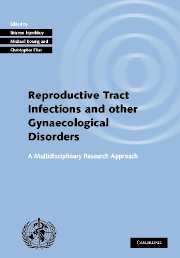 Investigating Reproductive Tract Infections and Other Gynaecological Disorders
Investigating Reproductive Tract Infections and Other Gynaecological Disorders Book contents
- Frontmatter
- Contents
- List of contributors
- Foreword by Paul F.A. Van Look
- Acknowledgements
- 1 Introduction and overview
- 2 Defining reproductive tract infections and other gynaecological morbidities
- 3 The social context of gynaecological morbidity: correlates, consequences and health seeking behaviour
- 4 Reproductive health: men's roles and men's rights
- 5 Study design for the measurement of gynaecological morbidity
- 6 Alternatives to community-based study designs for research on women's gynaecological morbidity
- 7 Community interaction in studies of gynaecological morbidity: experiences in Egypt, India and Uganda
- 8 Definitions of clinically diagnosed gynaecological morbidity resulting from reproductive tract infection
- 9 Laboratory tests for the detection of reproductive tract infections
- 10 Laboratory methods for the diagnosis of reproductive tract infections and selected conditions in population-based studies
- 11 The value of the imperfect: the contribution of interview surveys to the study of gynaecological ill health
- 12 Qualitative methods in gynaecological morbidity research
- 13 Integrating qualitative and quantitative methods in research on reproductive health
- 14 Interpreting results from different sources of data
- 15 Turning research into action
- Appendix A Notes on contributors
- Index
4 - Reproductive health: men's roles and men's rights
Published online by Cambridge University Press: 07 December 2009
- Frontmatter
- Contents
- List of contributors
- Foreword by Paul F.A. Van Look
- Acknowledgements
- 1 Introduction and overview
- 2 Defining reproductive tract infections and other gynaecological morbidities
- 3 The social context of gynaecological morbidity: correlates, consequences and health seeking behaviour
- 4 Reproductive health: men's roles and men's rights
- 5 Study design for the measurement of gynaecological morbidity
- 6 Alternatives to community-based study designs for research on women's gynaecological morbidity
- 7 Community interaction in studies of gynaecological morbidity: experiences in Egypt, India and Uganda
- 8 Definitions of clinically diagnosed gynaecological morbidity resulting from reproductive tract infection
- 9 Laboratory tests for the detection of reproductive tract infections
- 10 Laboratory methods for the diagnosis of reproductive tract infections and selected conditions in population-based studies
- 11 The value of the imperfect: the contribution of interview surveys to the study of gynaecological ill health
- 12 Qualitative methods in gynaecological morbidity research
- 13 Integrating qualitative and quantitative methods in research on reproductive health
- 14 Interpreting results from different sources of data
- 15 Turning research into action
- Appendix A Notes on contributors
- Index
Summary
Introduction: why men?
Recent years have seen several shifts in the emphasis and direction of reproductive health programmes. There has been a paradigm shift away from narrow concerns on demographic targets (through a concentration on population control and the delivery of family planning services) towards a more client-centred individual approach which is, in theory at least, both holistic and responsive to an individual's needs and well-being (Pachauri, 1999). This shift has arisen from separate directions that have combined to challenge the largely demographic imperative of lowering population growth rates towards a broader refocusing on human welfare and individual choice, and the public health goal of reducing reproductive and gynaecological morbidity (Collumbien and Hawkes, 2000). Proponents of the wider conceptual framework have defined reproductive health to include both ‘family planning and sexual health care’ (United Nations, 1994). Operationalizing this definition at a programme level implies provision of ‘the widest range of services without any form of coercion’. However, most of the policy and programme initiatives arising from this paradigm shift have so far been directed at women.
Much of this focus on women is largely historical. From the development of modern methods of contraception to the delivery of family planning programmes and the monitoring of outcomes via fertility surveys, women have been the central focus (Becker, 1996). Only recently has there been a recognition that a broadening of the reproductive health agenda away from fertility control to incorporate components such as management of sexually transmitted infections (STIs) or effective behaviour change communication, will necessitate the inclusion of men into previously predominantly female domains
- Type
- Chapter
- Information
- Investigating Reproductive Tract Infections and Other Gynaecological DisordersA Multidisciplinary Research Approach, pp. 82 - 105Publisher: Cambridge University PressPrint publication year: 2003
